Overcoming Pgp-mediated MDR with Cellax
Taxanes are a class of anticancer agents with a broad spectrum and have been widely used to treat a variety of cancer. However, its long term use has been hampered by accumulating toxicity and development of drug resistance. The most extensively reported mechanism of resistance is the overexpression of P-glycoprotein (Pgp). We have developed a PEGylated carboxymethylcellulose conjugate of docetaxel (Cellax), which condenses into ~120 nm nanoparticles. Here we demonstrated that Cellax therapy did not upregulate Pgp expression in MDA-MB-231 and EMT-6 breast tumor cells whereas a significant increase in Pgp expression was measured with native docetaxel (DTX) treatment.
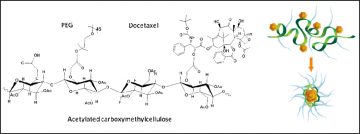
k
Figure 1. Schematic of Cellax chemical composition and self assembly. The structure is a representation of the DTX, PEG, and free carboxylic acid elements which is randomly distributed throughout the polymer chain. In aqueous medium, the Cellax polymer condenses into nanoparticles with a mean diameter around 120 nm.
(Roy & Murakami et al., 2014. https://www.ncbi.nlm.nih.gov/pmc/articles/PMC4122598/)
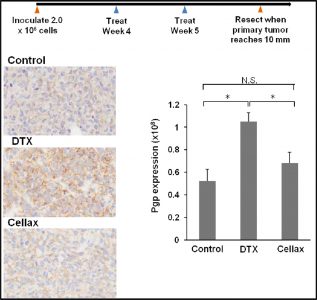
k
k
k
k
k
Figure 2. In vivo expression of Pgp protein in an orthotopic breast tumor model of MDA-MB-231. Cellax does not up-regulate P-glycoprotein, whereas DTX caused an overexpression of P-glycoprotein (Pgp).
(Roy & Murakami et al., 2014. https://www.ncbi.nlm.nih.gov/pmc/articles/PMC4122598/)
k
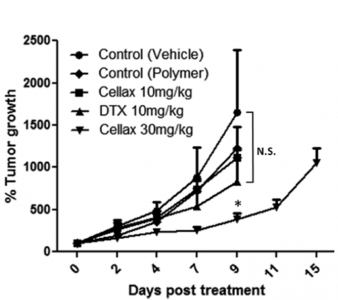
k
k
k
k
Figure 3. Cellax exhibits enhanced efficacy against MDR tumor. Both DTX and Cellax at 10 mg DTX/kg displayed little antitumor activity against this aggressive MDR tumor, while Cellax at an increased dose (30 mg DTX/kg) exhibited significant antitumor efficacy, and on day 9, the tumor growth inhibition was 90%.
(Roy & Murakami et al., 2014. https://www.ncbi.nlm.nih.gov/pmc/articles/PMC4122598/)
k
Overcoming Pgp-mediated MDR with Celludo
Podophyllotoxin (PPT) exhibited significant activity against P-glycoprotein MDR tumor cell lines; however, due to its poor solubility and high toxicity, PPT cannot be dosed systemically, preventing its clinical use for MDR cancer. We developed a nanoparticle dosage form of PPT by covalently conjugating PPT and polyethylene glycol (PEG) with acetylated carboxymethyl cellulose (CMC-Ac) using one-pot esterification chemistry. The biodistribution of the 20 nm PPT-NPs was highly selective to the tumor with 8-fold higher accumulation than all other examined tissues, while the larger PPT-NPs (30 and 120 nm) exhibited increased liver uptake. Within the tumor, >90% of the 20 nm PPT-NPs penetrated to the hypovascular core, while the larger particles were largely restricted in the hypervascular periphery.
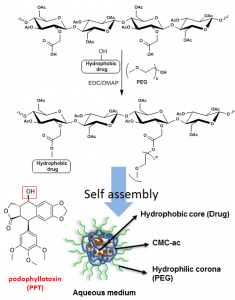
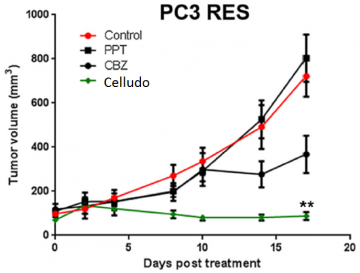
k
Figure 4. Celludo synthesis (left) and enhanced efficacy in treating prostate cancer demonstrated by celludo in comparison to PPT (right)
(Roy et al., 2015. http://www.sciencedirect.com/science/article/pii/S014296121500157X)